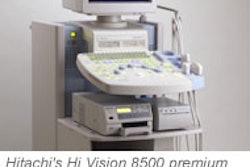Most surgically resected ovarian masses are benign, with a high incidence of benign ovarian pathology and non-specific sonographic appearance. Adopting a classification system for ovarian lesions, however, can reduce unnecessary resections, according to researchers from Massachusetts General Hospital in Boston.
"Ultrasound can classify adnexal masses based on the likelihood of benignity," said Dr. Andrew Akman, who presented the study at the 2003 RSNA meeting in Chicago earlier this month.
To test the value of a classification system, the study team correlated the sonographic features of 505 consecutive resected adnexal masses in 443 patients over 3.5 years with the final pathologic diagnosis. In the retrospective study, two readers blinded to the histology evaluated both transabdominal and transvaginal images by consensus, noting morphological features such as lesion size, presence of cystic or solid elements, and blood flow.
Of the lesions, 457 (90%) were benign. The non-benign lesions included primary epithelial tumors, borderline tumors, metastases, and malignant stromal tumors, Akman said.
The study team discovered that 179 of 179 (100%) lesions lacked a solid component and that 278/326 (85%) were benign. Lesions smaller than 4 cm were benign in 211 of 218 cases (97%), while 246 of 287 lesions (86%) larger than 4 cm were benign.
"Non-benign lesions tended to occur (at) greater than 4 cm, while the majority of benign lesions were less than 4 cm in size," Akman said. "Every lesion that did not have solid component… was found to be benign. Every non-benign lesion had some solid component…"
Of lesions without Doppler flow, 244 of 250 (98%) were benign, while lesions with flow were benign in 76 of 106 (72%) cases.
These criteria led to four lesion categories:
1a. Benign with no solid components.
1b. Benign with solid components measuring < 4 cm and demonstrating no flow.
2a. Indeterminate with solid components measuring > 4 cm.
2b. Indeterminate with solid components of any size demonstrating flow.
The researchers concluded that ovarian lesions can be classified as either benign requiring no further workup, or indeterminate requiring further evaluation such as further imaging or laparoscopy.
"Ultrasound can be used to predict malignancy of adnexal masses," Akman said. "In order to do this, grayscale and Doppler ultrasound are required."
Had lesions (in the first two lesion categories) been left alone, 47% of patients could have avoided surgery, the researchers concluded.
By Erik L. Ridley
AuntMinnie.com staff writer
December 19, 2003
Related Reading
US, CT show approximate parity for diagnosing appendicitis, December 10, 2003
Ovarian vein reflux: underdiagnosed and undertreated, June 20, 2003
No additional info offered by 3-D sonography of adnexal masses, June 19, 2003
Solid tumor on US favors metastatic ovarian cancer, June 6, 2003
Ultrasound exam key in work-up of polycystic ovarian infertility, June 5, 2003
Copyright © 2003 AuntMinnie.com



















